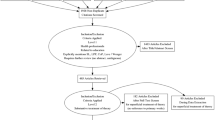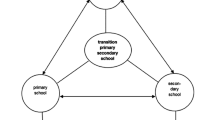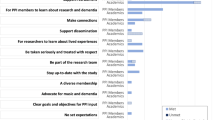Abstract
The nationwide scale-up of evidence-based and evidence-informed interventions has been widely recognized as a crucial step in ending the HIV epidemic. Although the successful delivery of interventions may involve intensive expert training, technical assistance (TA), and dedicated funding, most organizations attempt to replicate interventions without access to focused expert guidance. Thus, there is a grave need for initiatives that meaningfully address HIV health disparities while addressing these inherent limitations. Here, the Health Resources and Services Administration HIV/AIDS Bureau (HRSA HAB) initiative Using Evidence-Informed Interventions to Improve HIV Health Outcomes among People Living with HIV (E2i) piloted an alternative approach to implementation that de-emphasized expert training to naturalistically simulate the experience of future HIV service organizations with limited access to TA. The E2i approach combined the HAB-adapted Institute for Healthcare Improvement’s Breakthrough Series Collaborative Learning Model with HRSA HAB’s Implementation Science Framework, to create an innovative multi-tiered system of peer-to-peer learning that was piloted across 11 evidence-informed interventions at 25 Ryan White HIV/AIDS Program sites. Four key types of peer-to-peer learning exchanges (i.e., intervention, site, staff role, and organization specific) took place at biannual peer learning sessions, while quarterly intervention cohort calls and E2i monthly calls with site staff occurred during the action periods between learning sessions. Peer-to-peer learning fostered both experiential learning and community building and allowed site staff to formulate robust site-specific action plans for rapid cycle testing between learning sessions. Strategies that increase the effectiveness of interventions while decreasing TA could provide a blueprint for the rapid uptake and integration of HIV interventions nationwide.


Similar content being viewed by others
Change history
04 March 2024
A Correction to this paper has been published: https://doi.org/10.1007/s10461-024-04296-0
References
World Health Organization. The work of WHO on HIV: World Health Organization. 2002.
Trussell J, Fineberg HV, Stoto MA, Kaplan EH, Gable AR, Ruiz MS. No time to lose: getting more from HIV prevention. 2001.
Wingood GM, DiClemente RJ. The ADAPT-ITT model: a novel method of adapting evidence-based HIV Interventions. JAIDS J Acquir Immune Defic Syndr. 2008;47:S40–6. https://doi.org/10.1097/QAI.0b013e3181605df1.
Centers for Disease Control and Prevention. HIV Surveillance Report. 2020; https://www.cdc.gov/hiv/library/reports/hiv-surveillance.html. Accessed 2 Feb 2023.
Centers for Disease Control and Prevention. The State of the HIV Epidemic in the U.S. 2022; https://www.cdc.gov/nchhstp/newsroom/fact-sheets/hiv/state-of-the-hiv-epidemic-factsheet.html#recent-progress. Accessed 6 Feb 2023.
Frieden TR, Foti KE, Mermin J. Applying public health principles to the HIV epidemic—how are we doing? N Engl J Med. 2015;373(23):2281–7. https://doi.org/10.1056/NEJMms1513641.
Centers for Disease Control and Prevention. Monitoring selected national HIV prevention and care objectives by using HIV surveillance data—United States and 6 dependent areas, 2021. HIV Surveillance Supplemental Report 2023; 28(4). https://www.cdc.gov/hiv/library/reports/hiv-surveillance/vol-28-no-4/index.html.
Health Resources Services Administration. Ryan White HIV/AIDS Program Annual Client-Level Data Report 2021. http://ryanwhite.hrsa.gov/data/reports December 2022.
Fauci AS, Redfield RR, Sigounas G, Weahkee MD, Giroir BP. Ending the HIV epidemic: a plan for the United States. JAMA. 2019;321(9):844–5. https://doi.org/10.1001/jama.2019.1343.
Katz J, Wandersman A. Technical assistance to enhance prevention capacity: a research synthesis of the evidence base. Prev Sci. 2016;17(4):417–28. https://doi.org/10.1007/s11121-016-0636-5.
Mitchell RE, Florin P, Stevenson JF. Supporting community-based prevention and health promotion initiatives: developing effective technical assistance systems. Health Educ Behav. 2002;29(5):620–39. https://doi.org/10.1177/109019802237029.
Kilbourne AM, Neumann MS, Pincus HA, Bauer MS, Stall R. Implementing evidence-based interventions in health care: application of the replicating effective programs framework. Implement Sci. 2007;2(1):42. https://doi.org/10.1186/1748-5908-2-42.
Marc LG, Goldhammer H, Mayer KH, et al. Rapid implementation of evidence-informed interventions to improve hiv health outcomes among priority populations: the e2i initiative. Public Health Rep. 2022;137(4):617–24. https://doi.org/10.1177/00333549211027849.
Kilo CM. A framework for collaborative improvement lessons from the Institute for Healthcare Improvement’s breakthrough series. Qual Manag Health Care. 1998;6(4):1–13. https://doi.org/10.1097/00019514-199806040-00001.
Psihopaidas D, Cohen SM, West T, Avery L, Dempsey A, Brown K, Heath C, Cajina A, Phillips H, Young S, Stubbs-Smith A. Implementation science and the Health Resources and Services Administration’s Ryan White HIV/AIDS Program’s work towards ending the HIV epidemic in the United States. PLoS Med. 2020;17(11):e1003128. https://doi.org/10.1371/journal.pmed.1003128.
Bourdeau B, Shade S, Koester K, et al. Implementation Science Protocol: evaluating evidence-informed interventions to improve care for people with HIV seen in Ryan White HIV/AIDS program settings. AIDS Care. 2021;33(12):1551–9. https://doi.org/10.1080/09540121.2020.1861585.
The Institute for Healthcare Improvement. The breakthrough series: IHI’s collaborative model for achieving breakthrough improvement. Diabetes Spectr. 2004. https://doi.org/10.2337/diaspect.17.2.97.
Morris TH. Experiential learning—a systematic review and revision of Kolb’s model. Interact Learn Environ. 2020;28(8):1064–77. https://doi.org/10.1080/10494820.2019.1570279.
The National Quality Center. NQC Action Planning Guide for Quality Improvement. 2009; https://targethiv.org/library/nqc-action-planning-guide-quality-improvement. Accessed 22 Mar 2022.
The National Quality Center. NQC Action Planning Guide: Strategies for Implementing Your HIV Quality Improvement Activities. 2009; https://targethiv.org/sites/default/files/supporting-files/Strategies%20for%20Implementing%20Your%20Quality%20Improvement%20Activities.pdf. Accessed 22 Mar 2022.
Ebert L, Amaya-Jackson L, Markiewicz JM, Kisiel C, Fairbank JA. Use of the Breakthrough Series Collaborative to support broad and sustained use of evidence-based trauma treatment for children in community practice settings. Adm Policy Ment Health Ment Health Serv Res. 2012;39(3):187–99. https://doi.org/10.1007/s10488-011-0347-y.
De Freitas MR, Paiva SG, Junqueira BDF, Sousa P. Relation between quality improvement collaboratives and non-technical skills development: a systematic review of complex interventions. BMC Res Sq. 2021. https://doi.org/10.21203/rs.3.rs-312239/v1.
Center for Quality Improvement and Innovation (CQII). 2022; https://targethiv.org/cqii. Accessed 27 Mar 2022.
Acknowledgments
The authors acknowledge the following people for their efforts in support of the E2i initiative: the E2i Coordinating Center for Technical Assistance, The Fenway Institute, Fenway Health: Richard A. Cancio, MPH; Sarah Mitnick, BA; Tess McKenney, BA; Neeki Parsa, BA; and Reagin Wiklund, BS; Venton Hill- Jones, MS; Marvell Terry; the E2i Evaluation Center, University of California, San Francisco, Center for AIDS Prevention Research: Carol Dawson- Rose, RN, PhD, FAAN; Kimberly A. Koester, PhD; Mary A. Guzé, MPH; and Andres Maiorana, MA.
Funding
The authors disclosed receipt of the following financial support for the research, authorship, and/or publication of this article: This work was supported by the Health Resources & Services Administration (HRSA) of the US Department of Health and Human Services (HHS) (U69HA31067) to The Fenway Institute. No percentage of this project was financed with nongovernmental sources. This information and the content and conclusions of this article are those of the authors and should not be construed as the official position or policy of, nor should any endorsements be inferred by, HRSA, HHS, or the US government.
Author information
Authors and Affiliations
Corresponding author
Ethics declarations
Competing interest
Alex S. Keuroghlian declares royalties as editor of a McGraw Hill textbook on transgender and gender diverse health care and an American Psychiatric Association textbook on gender-affirming psychiatric care. The remaining authors have no competing interests to declare.
Additional information
Publisher's Note
Springer Nature remains neutral with regard to jurisdictional claims in published maps and institutional affiliations.
The original online version of this article was revised: "In the sentence beginning “Site staff presented their intervention…” in this article, the term ‘PDSA’ should have read‘PDCA’.
Rights and permissions
Springer Nature or its licensor (e.g. a society or other partner) holds exclusive rights to this article under a publishing agreement with the author(s) or other rightsholder(s); author self-archiving of the accepted manuscript version of this article is solely governed by the terms of such publishing agreement and applicable law.
About this article
Cite this article
Keuroghlian, A.S., Marc, L., Goldhammer, H. et al. A Peer-to-Peer Collaborative Learning Approach for the Implementation of Evidence-Informed Interventions to Improve HIV-Related Health Outcomes. AIDS Behav (2024). https://doi.org/10.1007/s10461-023-04260-4
Accepted:
Published:
DOI: https://doi.org/10.1007/s10461-023-04260-4




